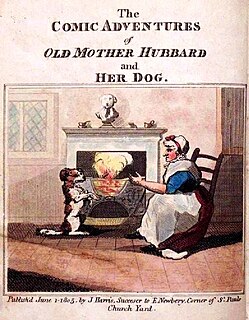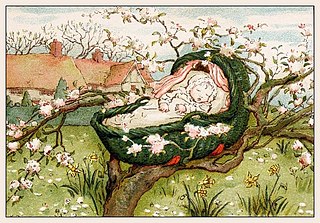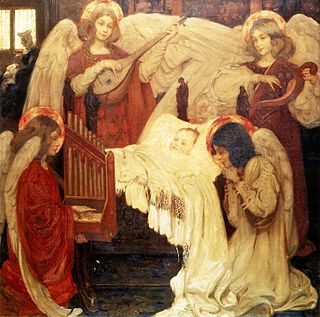Related Research Articles

A nursery rhyme is a traditional poem or song for children in Britain and many other countries, but usage of the term dates only from the late 18th/early 19th century. The term Mother Goose rhymes is interchangeable with nursery rhymes.
"Twinkle, Twinkle, Little Star" is a popular English lullaby. The lyrics are from an early-19th-century English poem written by Jane Taylor, "The Star". The poem, which is in couplet form, was first published in 1806 in Rhymes for the Nursery, a collection of poems by Taylor and her sister Ann. It is sung to the tune of the French melody "Ah! vous dirai-je, maman", which was published in 1761 and later arranged by several composers, including Mozart with Twelve Variations on "Ah vous dirai-je, Maman". The English lyrics have five stanzas, although only the first is widely known. It has a Roud Folk Song Index number of 7666.

Humpty Dumpty is a character in an English nursery rhyme, probably originally a riddle and one of the best known in the English-speaking world. He is typically portrayed as an anthropomorphic egg, though he is not explicitly described as such. The first recorded versions of the rhyme date from late eighteenth-century England and the tune from 1870 in James William Elliott's National Nursery Rhymes and Nursery Songs. Its origins are obscure, and several theories have been advanced to suggest original meanings.

"Yankee Doodle" is a traditional American song and a nursery rhyme, the early versions of which predate the Seven Years' War and American Revolution. It is often sung patriotically in the United States today and is the state anthem of Connecticut. Its Roud Folk Song Index number is 4501. The melody is thought to be much older than both the lyrics and the subject, going back to folk songs of Medieval Europe.
"The Grand Old Duke of York" is an English children's nursery rhyme, often performed as an action song. The eponymous duke has been argued to be a number of the bearers of that title, particularly Prince Frederick, Duke of York and Albany (1763–1827) and its lyrics have become proverbial for futile action. It has a Roud Folk Song Index number of 742.

"Old King Cole" is a British nursery rhyme first attested in 1708. Though there is much speculation about the identity of King Cole, it is unlikely that he can be identified reliably as any historical figure. It has a Roud Folk Song Index number of 1164. The poem describes a merry king who called for his pipe, bowl, and musicians, with the details varying among versions.

"Hey Diddle Diddle" is an English nursery rhyme. It has a Roud Folk Song Index number of 19478.

"Oranges and Lemons" is a traditional English nursery rhyme, folksong, and singing game which refers to the bells of several churches, all within or close to the City of London. It is listed in the Roud Folk Song Index as No 13190. The earliest known printed version appeared c. 1744.

"Jack and Jill" is a traditional English nursery rhyme. The Roud Folk Song Index classifies the commonest tune and its variations as number 10266, although it has been set to several others. The original rhyme dates back to the 18th century and different numbers of verses were later added, each with variations in the wording. Throughout the 19th century new versions of the story were written featuring different incidents. A number of theories continue to be advanced to explain the rhyme’s historical origin.

"London Bridge Is Falling Down" is a traditional English nursery rhyme and singing game, which is found in different versions all over the world. It deals with the dilapidation of London Bridge and attempts, realistic or fanciful, to repair it. It may date back to bridge-related rhymes and games of the Late Middle Ages, but the earliest records of the rhyme in English are from the 17th century. The lyrics were first printed in close to their modern form in the mid-18th century and became popular, particularly in Britain and the United States, during the 19th century.

"Simple Simon" is an English language nursery rhyme. It has a Roud Folk Song Index number of 19777.

"The Man in the Moon Stayed Up Too Late" is J. R. R. Tolkien's imagined original song behind the nursery rhyme "Hey Diddle Diddle ", invented by back formation. It was first published in Yorkshire Poetry magazine in 1923, and was reused in extended form in the 1954–55 The Lord of the Rings as a song sung by Frodo Baggins in the Prancing Pony inn. The extended version was republished in the 1962 collection The Adventures of Tom Bombadil.

"Old Mother Hubbard" is an English-language nursery rhyme, first given an extended printing in 1805, although the exact origin of the rhyme is disputed. It has a Roud Folk Song Index number of 19334. After a notable nursery success, it was eventually adapted to a large variety of practical and entertaining uses.

"Little Jack Horner" is a popular English nursery rhyme with the Roud Folk Song Index number 13027. First mentioned in the 18th century, it was early associated with acts of opportunism, particularly in politics. Moralists also rewrote and expanded the poem so as to counter its celebration of greediness. The name of Jack Horner also came to be applied to a completely different and older poem on a folkloric theme; and in the 19th century it was claimed that the rhyme was originally composed in satirical reference to the dishonest actions of Thomas Horner in the Tudor period.

"Ring a Ring o' Roses", "Ring a Ring o' Rosie", or "Ring Around the Rosie", is a nursery rhyme, folk song and playground singing game. Descriptions first emerge in the mid-19th century, but are reported as dating from decades before, and similar rhymes are known from across Europe. It has a Roud Folk Song Index number of 7925.

A children's song may be a nursery rhyme set to music, a song that children invent and share among themselves or a modern creation intended for entertainment, use in the home or education. Although children's songs have been recorded and studied in some cultures more than others, they appear to be universal in human society.

"This Little Piggy" or "This Little Pig" is an English-language nursery rhyme and fingerplay. It has a Roud Folk Song Index number of 19297.

"Rock-a-bye baby in the tree top" is a nursery rhyme and lullaby. It has a Roud Folk Song Index number of 2768.

"Matthew, Mark, Luke and John", also known as the "Black Paternoster", is an English children's bedtime prayer and nursery rhyme. It has a Roud Folk Song Index number of 1704. It may have origins in ancient Babylonian prayers and was being used in a Christian version in late Medieval Germany. The earliest extant version in English can be traced to the mid-sixteenth century. It was mentioned by English Protestant writers as a "popish" or magical charm. It is related to other prayers, including a "Green" and "White Paternoster", which can be traced to late Medieval England and with which it is often confused. It has been the inspiration for a number of literary works by figures including Henry Wadsworth Longfellow and musical works by figures such as Gustav Holst. It has been the subject of alternative versions and satires.
References
- ↑ Walter Thornbury (1865), "Simon and his Dog", Haunted London, Chatto & Windus, pp. 405–407